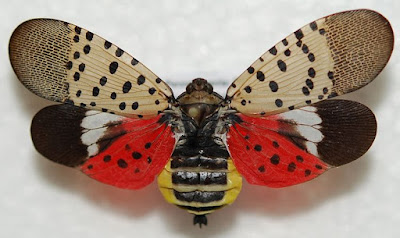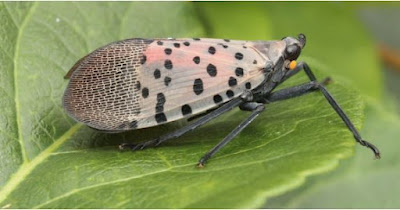A spotted lanternfly, a dangerous invasive, spotted in Annandale
 |
| An adult spotted lanternfly. [Pennsylvania Department of Agriculture] |
If you see a spotted lanternfly, an invasive insect that has made its way to Virginia, the Fairfax County government wants you to kill it immediately.
A “hitchhiker” adult spotted lanternfly was recently found in a shipment of produce at a grocery store in Annandale. There have also been sightings in Loudoun County.
These pests, originally natives of Southeast Asia, are now found throughout the United States. They were first seen in Virginia in 2018.
They can cause serious damage to home and commercial gardens and are a particular threat to the state’s peach, apple, grape, and wine industries.
Spotted lanternflies are different colors at different ages. Nymphs can be black and white or red, black, and white.
 |
| Spotted lanternfly nymphs. [Virginia Cooperative Extension] |
Adults have gray-brown forewings, a black head, and black spots. When at rest the crimson hind wings can be partially seen through the semi-translucent forewings, which gives the insect a reddish cast. The
lanternfly’s abdomen is yellow with black and white bands on the tip and bottom.
Spotted lanternflies can be found on trees, wood, plant and landscape materials, rocks, and vehicles.
Adults begin laying eggs in October and through the first few hard frosts. The egg masses are covered in a light gray wax that looks like mud when it dries. From October through July, the egg masses can be scraped off trees or other structures and dropped into containers of rubbing alcohol or hand
sanitizer.
From mid-May through August, insecticide can be applied to the bugs’ main host, the tree-of-heaven, an invasive tree native to China.
Related story: Residents can help prevent beetle invasion
Throughout the remainder of the year, stump treatments, hack and squirt treatments, foliar sprays, and basal bark sprays can be used to get rid of these pests.
Spotted lanternflies feed on plant sap and excrete a sticky substance called “honeydew,” which attracts wasps and ants. The honeydew also encourages “sooty mold” growth on plants and trees. This black mold can cover leaf surfaces, stunt plant growth, and ruin crops.
 |
| An adult spotted lanternfly on a leaf. |
A spotted lanternfly quarantine is in effect in the City of Winchester and Frederick, Clarke, and Warren counties to slow the spread of this insect to un-infested areas of Virginia. Businesses in the quarantined
areas are required to obtain state permits and inspect regulated items.
For more information, contact the Forest Pest Management Branch at the Fairfax County Urban Forest Management Division, 703-324-1770, [email protected].

